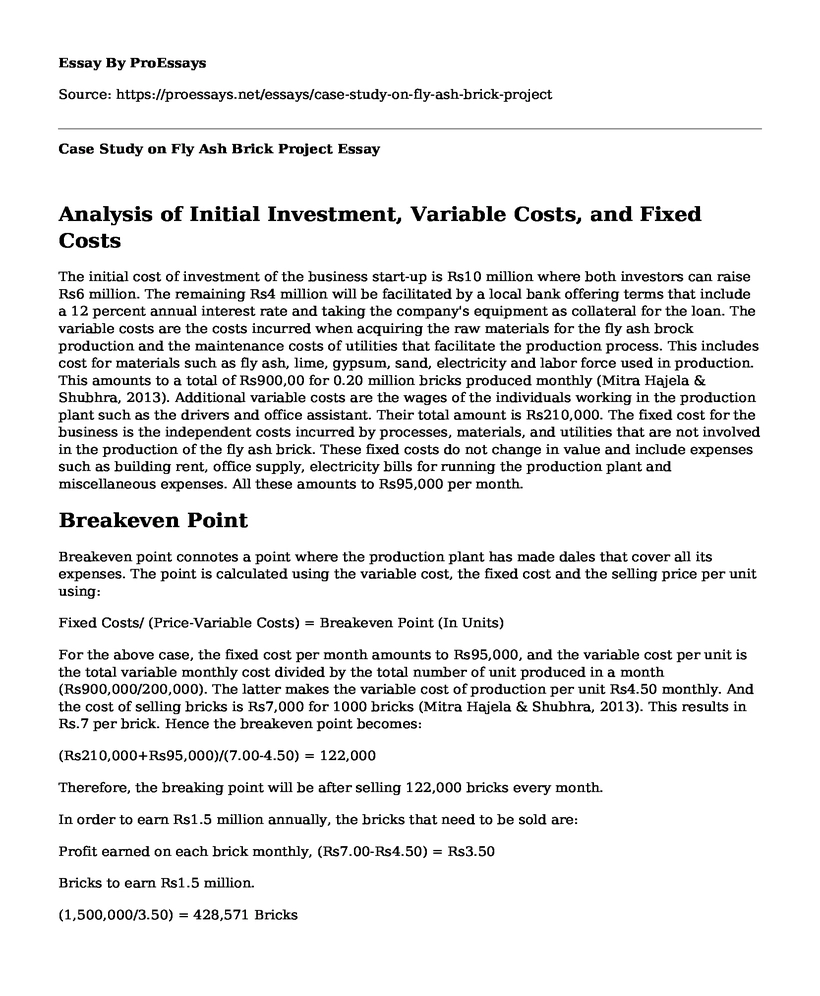Analysis of Initial Investment, Variable Costs, and Fixed Costs
The initial cost of investment of the business start-up is Rs10 million where both investors can raise Rs6 million. The remaining Rs4 million will be facilitated by a local bank offering terms that include a 12 percent annual interest rate and taking the company's equipment as collateral for the loan. The variable costs are the costs incurred when acquiring the raw materials for the fly ash brock production and the maintenance costs of utilities that facilitate the production process. This includes cost for materials such as fly ash, lime, gypsum, sand, electricity and labor force used in production. This amounts to a total of Rs900,00 for 0.20 million bricks produced monthly (Mitra Hajela & Shubhra, 2013). Additional variable costs are the wages of the individuals working in the production plant such as the drivers and office assistant. Their total amount is Rs210,000. The fixed cost for the business is the independent costs incurred by processes, materials, and utilities that are not involved in the production of the fly ash brick. These fixed costs do not change in value and include expenses such as building rent, office supply, electricity bills for running the production plant and miscellaneous expenses. All these amounts to Rs95,000 per month.Breakeven Point
Breakeven point connotes a point where the production plant has made dales that cover all its expenses. The point is calculated using the variable cost, the fixed cost and the selling price per unit using:
Fixed Costs/ (Price-Variable Costs) = Breakeven Point (In Units)
For the above case, the fixed cost per month amounts to Rs95,000, and the variable cost per unit is the total variable monthly cost divided by the total number of unit produced in a month (Rs900,000/200,000). The latter makes the variable cost of production per unit Rs4.50 monthly. And the cost of selling bricks is Rs7,000 for 1000 bricks (Mitra Hajela & Shubhra, 2013). This results in Rs.7 per brick. Hence the breakeven point becomes:
(Rs210,000+Rs95,000)/(7.00-4.50) = 122,000
Therefore, the breaking point will be after selling 122,000 bricks every month.
In order to earn Rs1.5 million annually, the bricks that need to be sold are:
Profit earned on each brick monthly, (Rs7.00-Rs4.50) = Rs3.50
Bricks to earn Rs1.5 million.
(1,500,000/3.50) = 428,571 Bricks
Return on Equity (ROE)
Increase in volume does not improve the return on equity for a company since increase in volume does not necessarily come with profit. Unless a profit is made with an increase in volume, no matter how small individual units are sold, the pricing will be the primary control. However, with regards to asset turnover, the comparison between the volume of production of a company vis-a-vis the company's asset results in a change in the return on equity. All other things being constant, higher asset turnover contributes to higher return on equity values.
Advice to the Stakeholder of the Fly Ash Brick Project
The two stakeholders should be focused on their company dynamics and know what they want to do, what goals they want to achieve and in a specific timeline. They should capitalize on the cheapness of the fly ash to produce even more bricks and supply cheaply to gain more profit within their market niche as they expand to new markets. They should keep up with environmental conservation as part of fly ash rehabilitation from coal and thermal power processing plants.
References
Mitra S. K. and Hajela Shubhra (2013). "Fly Ash Brick Project: Feasibility Study Using Cvp." Analysis Ivey Business School, Western University, London, Ontario, Canada, N6G 0N1
Cite this page
Case Study on Fly Ash Brick Project. (2022, Apr 04). Retrieved from https://proessays.net/essays/case-study-on-fly-ash-brick-project
If you are the original author of this essay and no longer wish to have it published on the ProEssays website, please click below to request its removal:
- Internal Business Planning: Company Description
- Perpetuating the Family Business Paper Example
- Domino's Pizza Case Study Report
- Essay Sample on Intercultural Communication in International Business
- VP of Mary Land Production Facility Plan to Breach Capital Expenditure Freeze - Essay Sample
- Essay on Planning Your Future: Leverage Design Thinking, Entrepreneurship, & Innovation to Shape Your Career
- Essay Example on Foodservice Cost Control: Issues & Recommendations







